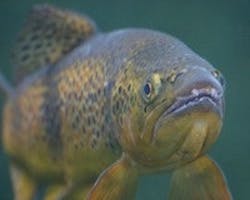Collaboration Protects Endangered Salmon, Steelhead Trout
Collaboration among federal and state agencies, rice growers and industry has created federally enforceable restrictions of the pesticide thiobencarb to protect threatened and endangered salmon and steelhead trout in California.
“Working hand-in-hand with our partners we have met the critical environmental and economic goals of protecting threatened and endangered salmon and steelhead trout while maintaining rice production in California,” said Jim Jones, assistant administrator for Chemical Safety and Pollution Prevention. “This was achieved by creating a unique approach tailored to specific geographic locations critical to salmon and considering the needs of rice growers. I am proud of our joint efforts to protect threatened and endangered salmon.”
"This is a smart approach to pesticide use that includes important safeguards for protected fish while still allowing growers to care for their crops," said Will Stelle, administrator of NOAA Fisheries' West Coast Region." This demonstrates that we can find balanced and workable solutions through collaboration."
National Oceanic Atmospheric Administration (NOAA) Fisheries, the U.S. Environmental Protection Agency (EPA), California Department of Pesticide Regulation (CDPR), the California Rice Commission and Valent, the manufacturer of the pesticide thiobencarb, worked to put these restrictions in place.
The CDPR put in place measures to protect salmon and steelhead trout based on proximity to endangered species habitat according to NOAA Fisheries geographic locations and information from rice growers. After reviewing CDPR’s data on pesticide use and the state’s protective measures, NOAA Fisheries found that thiobencarb use on rice in California would not jeopardize salmon and steelhead trout provided protective measures currently being applied in California are ensured.
EPA is now making California’s geographic use limits federally enforceable by incorporating them into the pesticide label. These use limitations will be effective April 1, 2015. This action represents EPA’s first implementation of a NOAA Fisheries salmon and steelhead trout Biological Opinion. This action was a result of litigation brought against EPA and NOAA Fisheries by the Washington Toxics Coalition (WTC) and the Northwest Center for Alternatives to Pesticides (NCAP). NOAA Fisheries’ final Biological Opinion for thiobencarb.
The protection measures included in the NOAA Fisheries’ final Biological Opinion came from several sources including the California enforcement standards, the use limitations on California’s on-line database that recommends protective measures for endangered and threatened species and from the management practices the California Rice Commission receives from the Central Valley Regional Water Quality Control Board.
California is the only state within the range of Pacific salmon and steelhead trout where rice is grown. Thiobencarb is typically used on rice from May 1 through June 15.
Source: EPA
